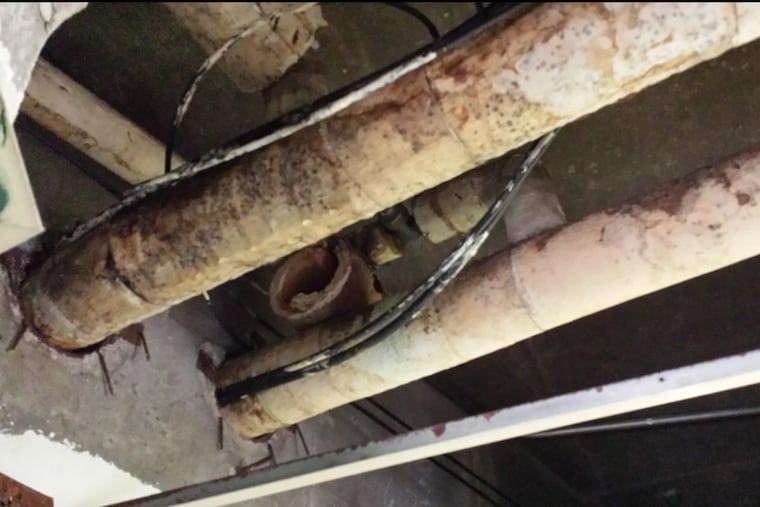Despite district claim, mold festered at Philadelphia school for years
The Philadelphia School District said it was closing John B. Kelly Elementary School because it found "traces" of mold. But the Germantown school was plagued with mold and leaky pipes since at least 2015.

When the Philadelphia School District received a report of "possible mold" Wednesday at an elementary school in the city's Germantown section, it quickly investigated, it said. Within hours, the district closed the school, saying it found "traces of mold" in several classrooms.
In fact, building inspectors found more than 600 square feet of mold in 10 classrooms at John B. Kelly Elementary School, said Arthur Steinberg, head of the Philadelphia Federation of Teachers Health and Welfare Fund, which monitors building conditions.
"I don't want to call anyone a liar," Steinberg said. "However, they obviously define … 'traces' differently than I do."
On Thursday, investigators discovered an additional 400 square feet of the fungus in 15 other places at the 650-student school, including hallways, bathrooms, and closets.
It should have come as no surprise. Mold has been rampant throughout the school for years.
As far back as 2015, teachers repeatedly alerted district and union officials to mold, leaking pipes, and ventilation problems at the school at Pulaski Avenue and Hansberry Street.
In November 2015, after teachers complained of respiratory problems and illness, the School District and the teachers' union discovered widespread mold on chairs, desks, and ceiling pipes. It was so extensive in music rooms that the spaces were deemed "unusable," according to a report prepared by an environmental scientist for the teachers' union.
In early 2016, teacher Stephen Flemming became so distraught about mold and leaks throughout the 1970 two-story building that he sent School Superintendent William R. Hite Jr. a photo of what he believed was mold in a first-floor classroom, with a plea that concluded: "Please help us."
Hite wrote back that morning: "We will have someone out there ASAP to look into this."
The district sent maintenance workers and plumbers to the school, Flemming said, but the problems weren't fixed.
Flemming said he occasionally had to move his students to the cafeteria and the library to get away from the stench of a heavy industrial trash can in his classroom, used to catch filthy water leaking from a ceiling pipe. He taught at the school for 10 years until moving this fall to a district high school.
Steinberg said the district's maintenance system shows that the 83 problems reported at Kelly since 2015 — half of them about mold and moisture — have all been repaired except for two. But that accounting can't be the true picture, given the current condition of the school, Steinberg said.
"Instead of taking proactive — and cost-effective — steps to remediate the mold when it was reported, the district allowed the situation to worsen to the point that the school had to be closed to address the issue," Jerry Jordan, head of the teachers' union, said in a statement Thursday.
School District spokesman Lee Whack, responding late Thursday to Jordan's statement, said: "We meet with the PFT on a weekly basis. If they had reports like this about mold in the school dating back over some time, why didn't they bring it up?"
Whack said the School District wants to have a "true partnership" with the union and "work in lockstep to fix problems."
Earlier Thursday, district spokesman Kevin Geary said the district first learned of "some potential issues" with mold on Wednesday and went to investigate within an hour. The problem was caused by heating, ventilation, and air-conditioning malfunctions, he said.
"The safety and health of our students and staff is our highest priority," the district said in a statement Thursday. "The School District will not reopen the school until it is mold-free."
Mold can trigger asthma and cause a host of health problems, including respiratory infections and eye and throat irritations. Kelly has a large number of students with asthma.
Mold contamination in schools has recently made headlines in the region after six schools in Gloucester County were closed while officials grappled with the health hazard, triggering community uproar.
Stephanie Mathis, a fifth-grade teacher at Kelly, said ceiling tiles are missing in her first-floor classroom, exposing a pipe covered in "black mold."
"Last spring, it was leaking in five places. There was water on my floor. There was a child who slipped and fell on the floor."
"My room smells like mold and mildew every day," she said. "There are little gnats that fly around in the air because it's so moist. My bulletin board paper is always wrinkled because it's so moist."
Mathis said she had pneumonia at the beginning of this school year and didn't get better even with antibiotics. Her doctor told her to take 2½ weeks off to completely recover. She went back to the school on Monday. By Tuesday, she was coughing again, she said.
"The children should not be sitting in that type of environment with leaking pipes and mold. It's just not healthy. What message does that send to children? It sends the message that people don't care," she said.
Staff writer Kristen A. Graham contributed to this article.